By Gaulbert Sutherland
Photos by Arian Browne
Between crumbling banks of yellow laterite, the Konawaruk River snakes its way downstream, the reddish-yellow waters glistening in the sun, a festering cut amid the towering greenery of the Region Eight jungle.
Nothing stirs below the surface of the silent river. “There ain gat no particular life form that can survive in the water except alligator and even them struggle…the water so murky,” said Floyd Perry, a shop-owner at Mousie Landing, one of several tiny, temporary settlements where miners come to get supplies close to the Konawaruk. “That is sheer mud, fish can’t survive in there at all,” he said.
Branded a “dead” river – incapable of supporting fish or other aquatic life-by environmentalists and a few mining officials over a decade ago, little seemed to have changed for the Konawaruk, with the river filled with sediment giving the water a murky reddish-yellow colour. It has been that way for years, several miners told Stabroek News during a visit two weeks to the river, deep in the jungle and goldfields of Region Eight. The river, located in the Mahdia-Potaro Mining District is about 60 miles long.
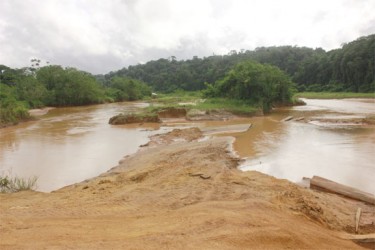
The state of the river highlights the governance challenges facing the sector with little action taken and no immediate plan to rehabilitate the waterway, more than a decade after attention was drawn to its severely degraded condition.
The transformation from clear, dark water to murky, reddish-yellow water started when miners seeking gold and diamonds began to dredge the riverbed and banks over two decades ago and worsened over the years, said Romel Bennett, a miner who began diving in the area in 1987. Prior to that, mining had taken place in the river for years with British Guiana Consolidated Enterprise Limited mining the area extensively, beginning in the 1950’s. But even before then, mining had taken place there in the early 1900’s said former head of the Guyana Geology and Mines Commission (GGMC) William Woolford.
Then, the water pollution was mainly caused by water dredges but these days it is land dredges that cause the river to remain in its sediment-filled state, Bennett said. “What most making the water like that is land dredge…water from the backdam running in the creek,” Perry further explained.
Turbidity- a measure of water clarity – of waterways in the interior caused by land dredging and river bank mining operations are major environmental issues related to Guyana’s mining sector and scientists say that turbidity could affect biota, degrade the drinking and domestic water quality for communities living downstream of mining operations, and give rise to discolouration plumes that had a negative impact on local communities and other natural resources users.
Mining in the Potaro-Mahdia area has increased substantially over the past few years given high gold prices and many smaller streams have become polluted and filled with sediment as miners use the water during their operations. Mining regulations to prevent environmental infractions have largely been unenforced with limited human resources being a major factor according to several studies done on the sector.
The question of whether or not the Konawaruk River is “dead” has drawn varying views. “It would be difficult to say that without carrying out a proper assessment,” said Dr. David Singh, the head of Conservation International-Guyana. However, he pointed out that the period for which the river has remained in a heavily polluted state-10 to 15 years- is more than the lifespan of aquatic species.
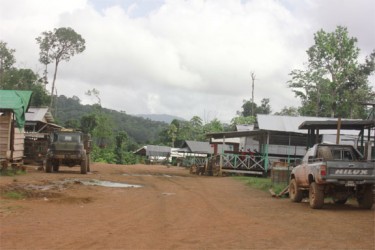
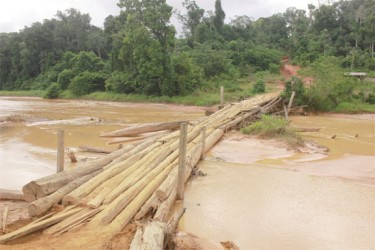
Fifteen years is not “temporary,” he said while emphasizing that an assessment should be done to determine whether the Konawaruk River still sustains life in a viable form “that the Guyanese people can be happy with.” He also questioned whether the waterway can recuperate after so many years of damage.
“We are aware of the perspective that these disturbances are supposed to be temporary and allowing for the recovery of the ecosystem. One then has to ask whether the conditions which are now existing for more than 10-15 years can still be considered temporary and whether there is not an alternative approach that can be taken,” the conservationist added.
Woolford, now a consultant in the mining industry, is adamant that the Konawaruk River is not dead. Such an assessment, he said, cannot be done by sight and studies done by the GGMC over the years showed that the river was still sustaining life. However, he acknowledged that he does not know the present status of the river.
“As far as I am concerned, it’s not damaged. Nature is very robust,” he added. Woolford said that after mining ceases, the river would regenerate like others such as the Potaro had done before. “There is hope for all places where you have land disturbances, for regeneration in the tropical environment,” he said.
Miners say that nothing can be done to restore the river to a state where the water is clear as it was before unless mining is stopped. “Nothing actually can be done to the river,” said Perry who pointed out that there are mines on both sides of the river which discharge tailings- a mixture of water and mud- into the waterway. “That is why the water can’t change. That is sheer mud…fish can’t survive in there at all,” said the businessman who has been in the area for the past five years. “That pollution business, I don’t know what they could come up with,” he added.
GGMC commissioner Rickford Vieira said that mines officers are supposed to be monitoring the area. There is a GGMC camp at Konawaruk close to Mousie Landing with the main facility for the district based at Mahdia. However, he emphasized that they cannot do everything given the scattered nature of the many mining operations. In addition, the improved telecommunication links such as satellite phones make it easy for miners to alert others when mines officers are coming to make checks, he said.
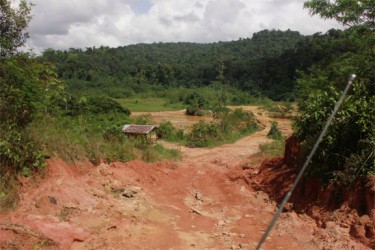
Vieira said that mines officers would normally try to prevent infractions against mining regulations-such as tailings from mines being discharged directly into the river rather than into a pond constructed for this purpose- but this is difficult. “We need more people to adequately monitor these situations,” he said adding that the current complement of mines officers is inadequate to deal with the continuing challenges of the mining sector.
The GGMC head said that they also expect other agencies to do what they need to do. The rehabilitation of rivers is not under the immediate remit of the GGMC, he said.
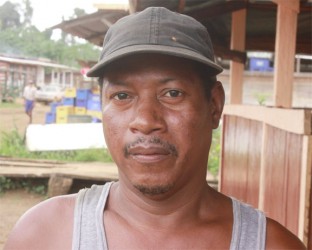
Further, Vieira pointed out, the GGMC is focusing on land mining because “the land issue is bigger.” The agency cannot do everything at once, the GGMC commissioner said. He added that miners also need to do what is required and obey the law.
With little change to the muddied state of the river over the years and no immediate plans to rehabilitate the waterway, its future is uncertain. Damage to the river continues.
Up the Konawaruk River, some dredges operate in the waterway at the Blackwater Creek area. “When rain stop fall, dem man (miners) does block the creek up there and you see the water, it more muddy,” Bennett said. The number of miners in the area has also increased over the years, Perry added.
The shopowners and miners at Mousie landing cannot use water from the Konawaruk River for any purpose. They go over the river using a crude, rickety bridge made out of logs to get to a stream close to the GGMC camp to get water for washing and bathing. It costs $4000 to get a barrel of water from the stream to Mousie Landing, Nicole Fordyce, a shopkeeper, said. They also catch rainwater and purchase bottled water for drinking due to the fear of typhoid. She said she has not witnessed any efforts by the GGMC to clean up the Konawaruk and feels that this should be done.
However, Bennett said that if the authorities move to do so, it means that “they got to stop mining.”
Woolford remains confident that nature will take care of the river. In the early 1900’s, he said, mining using “bucket-line” dredges began in the rivers of the Potaro district. The Lower Potaro, Mahdia, Konawaruk, North Fork and Minnehaha rivers were “substantially mined” for the gold on the river bed with mercury-plated sheets on a pad used to trap the gold. Much of the mercury-which is toxic and accumulates in the food chain- escaped, Woolford said.
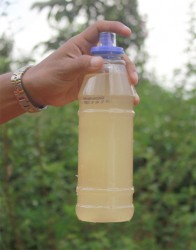
The former mines commissioner stressed that these rivers are not “pristine” and despite being substantially disturbed, have recovered. Mining still occurs in some of these rivers. “After mining ceases, the (Konawaruk) river would recuperate as others did before,” he said. Woolford pointed out that in the 1960’s persons said that the Konawaruk River was pristine but they did not know it was mined before. “It had substantially regenerated after several years,” he said. “The whole idea of being dead gives the impression that it cannot be regenerated,” he said while adding that “good regeneration” can occur in the tropical environment.
On the more recent history of the Konawaruk River, Woolford said that when he became acting commissioner in 1991, the agency had commissioned a study and the results showed that sedimentation did not
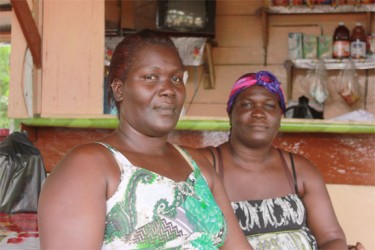
exceed World Health Organisation standards. “There was nothing wrong at the time with the sedimentation of the river,” he recounted.
Subsequently, however, as the murkiness of the water increased, environmentalists and even some mining officials declared that the Konawaruk River was “dead.”
Woolford said that about four years ago, a follow-up study was done after a company, North American Resources Limited, began mining the banks of the river. He said that the results showed that the turbidity level was beyond what was set out in the mining regulations and the company was ordered to stop operating until they could remedy the problem. “I don’t know what is the status at the moment,” he said adding that by the time he retired a couple years ago, the situation was not remedied. He further noted that an agreement was reached for the company to change their mining practices.
The retired mines commissioner also said that there has to be heavy sedimentation to cause the death of fish and a study done via the Commonwealth Secretariat found that “there was no dangerous fish kill.” He said that regeneration is a scientific and practical fact.
Woolford further said that land disturbance is not the exclusive domain of miners and pointed to the impacts of agricultural and infrastructural development.
Dr. Singh said that he appreciates the view that landscapes cannot remain the same when carrying out activities like mining. However, how this is dealt with is important and after 15 years, it is a physical, permanent change, he said. The conservationist noted the arguments used by miners that the change is temporary but questioned how long is temporary and whether the river can recuperate “after so many years of damage.” He also pointed out that there was not only physical change but also ecological change.
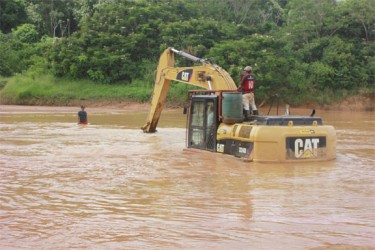
What needs to be done, he said, is to design and execute mining in a way that takes into account the social and environmental costs.
There are regulations that deal with environmental aspects of mining but like other countries in the region where mining is done, enforcement is lax. The region has many laws relating to the environment, but the lack of management and capacity to implement them has limited their effectiveness, the United Nations Environment Programme’s GEO-5 report, released last year, said. It noted that apart from land degradation, water and biodiversity are also affected by unsustainable practices.
“Governments need a stronger commitment to new policies and to making existing policies and mechanisms more effective through adequate financial resources, scientific research and information, a culture of environmental awareness and standard governance principles such as transparency, accountability and inclusion,” the report states.
Reports done on the local mining sector have found that currently the level of compliance with post-operation restoration regulations is low. Among others, this is due to very limited knowledge of miners regarding how to perform ecologically appropriate land restoration. In addition, a 2007 study by the Harvard Law School found that the amount to be paid as a reclamation bond was very small compared to the likely damage from mining operations.
Officials have also acknowledged that the GGMC is understaffed with field inspectors though currently efforts are being made to recruit more. A consultancy done for the Ministry of Natural Resources and the Environment this year states that sufficient measures to address deforestation and forest degradation impacts by the mining sector do not seem in place at this moment.
In the Konawaruk, mining seems to be on the increase. An excavator, like a giant insect, lumbers across the riverbed, stirring up sediments and turning the water red. Yellow laterite from the exposed riverbank tumbles into the channel.
Dr Singh recalled visiting the river over a decade ago prior to joining Conservation International. “It was very bad. The sediment load was extremely high. The banks were very badly eroded away and the course of the river was changing,” he said. A decade later, the situation remains the same.




